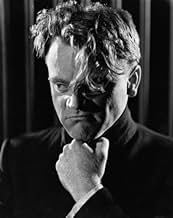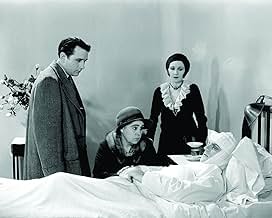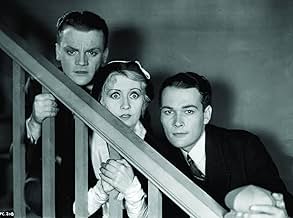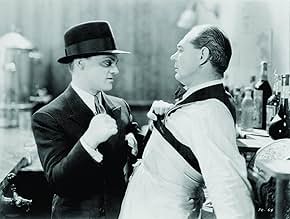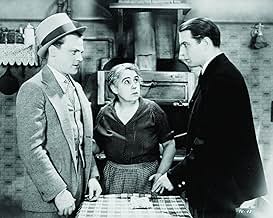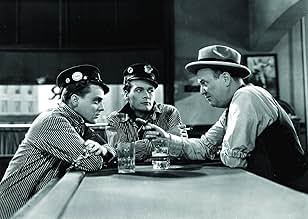अपनी भाषा में प्लॉट जोड़ेंAn Irish-American street punk tries to make it big in the world of organized crime.An Irish-American street punk tries to make it big in the world of organized crime.An Irish-American street punk tries to make it big in the world of organized crime.
- निर्देशक
- लेखक
- स्टार
- 1 ऑस्कर के लिए नामांकित
- 1 जीत और कुल 1 नामांकन
- Paddy Ryan
- (as Robert O'Connor)
- Goon
- (बिना क्रेडिट के)
- Dutch
- (बिना क्रेडिट के)
- Kitty
- (बिना क्रेडिट के)
- Tom as a Boy
- (बिना क्रेडिट के)
- Machine Gunner
- (बिना क्रेडिट के)
- Matt as a Boy
- (बिना क्रेडिट के)
- Miller
- (बिना क्रेडिट के)
- Molly Doyle
- (बिना क्रेडिट के)
- Nails' Girl
- (बिना क्रेडिट के)
फ़ीचर्ड समीक्षाएं
The script is loosely adapted from "Beer and Blood", an unpublished book from John Bright and Kubec Glasmon on the life of Dean O'Banion, Al Capone's biggest rival. We see a variety of references to Irish mobsters, including Samuel "Nails" Morton, who was famously killed by a horse. Just like the real-life mobster, Samuel "Nails" Nathan of the film is avenged when the horse is shot.
This is, of course, Cagney's breakout role. And what better role for him? Prior to "Public Enemy", he had been a hoofer on the New York stage. This experience really solidified him as a notable actor, as he had control over his movements that others might not have. Interestingly, he was originally cast as the good guy -- the last minute switch probably saved this movie as well as marked the decision that would catapult Cagney to stardom. (Some scenes were even filmed with Cagney in the other role before director William Wellman realized his mistake.)
As for how the dance background helped his acting, critic Lincoln Kirstein noted Cagney "has an inspired sense of timing, an arrogant style, a pride in the control of his body and a conviction and lack of self-consciousness that is unique. No one expresses more clearly in terms of pictorial action the delights of violence, the overtones of a subconscious sadism, the tendency towards destruction, toward anarchy, which is the base of American sex appeal." Beautifully said.
Playwright Robert Sherwood expressed how Cagney's character was the ideal anti-hero. He wrote that Cagney "does not hesitate to represent Tom as a complete rat -- with a rat's sense of honor, a rat's capacity for human love; and when cornered, a rat's fighting courage. And what is more, although his role is consistently unsympathetic, Mr. Cagney manages to earn for Tom Powers the audience's affection and esteem."
In its own time, the film was thought of as a bit too violent, and there are a few moments that might still be considered shocking today. However, with the changing norms between the 1930s and today, what really stands out is the misogyny that barely earned a mention upon release. The most memorable scene, of course, is Cagney smashing a grapefruit into Mae Clarke's face. But his abusive language to her, suggesting his desire to drown Clarke, is hard to take and still remain empathetic with the gangster.
There are very few films that can be said to be really inspirational to the gangster film. This one, Howard Hawks' "Scarface" (1932) and "Little Caesar" (1931) are at the top of that short list. If it is not evident enough from watching the film itself, the special feature interview of Martin Scorsese should cement the deal. Author TJ English feels this is "perhaps the most influential gangster flick in the history of American movies", but that may be overstating it a little.
Some credit must be given for "Public Enemy" succeeding and remaining a top film, however. As strange as it sounds, there were at least 25 gangster movies in 1931 and at least 40 in 1932. So being among the one or two remembered almost a century later is actually quite a feat. Even William Wellman, who directed a staggering nine gangster films between 1928 and 1933 is really only remembered for this one.
While we may never literally create a time machine, these old movies give you the miracle of observation at least of what life was once like. Sadly many of the old films have been destroyed through neglect, so the pickings are very slim. Public Enemy is one of the best old movies available. For only the sheer pleasure of seeing what all the fuss was about in Cagney and Harlow, it's worth a viewing. Director Wellman creates some extremely lasting images you won't want to miss, and it almost makes me think of the original Frankenstein for that reason. The final sequence especially is a dramatic example of lasting imagery in film, quite an unforgettable experience. If you like Godfather, Scarface, Goodfellas, and who doesn't, you owe it yourself to watch what may be the patriarch of the entire genre. Interestingly, while the film has a campy disclaimer demonizing the subject matter and mandating public action in order to address the evils of organized crime, it's rather obvious that the producers new exactly what they were really doing by making a film like this. Brutal as some of the action is, Cagney's charisma glorifies the gangster as much as Coppola, Scorsese and all the rest glorify modern organized crime. See it for yourself!!!
Powerful portrait of the rise and fall of a nasty gangster extraordinarily performed by James Cagney
Classic gangster movie contains top-notch performances , unpretentious familiar drama, thrills , fast-paced , action , and a shocking final . Magnificent James Cagney in the title role as a snarling and ominous gangster . Edward Woods was originally hired for the lead role of Tom Powers and James Cagney was hired to play Matt Doyle, his friend . However, once director William A. Wellman got to know both of them and saw Cagney in rehearsals, he realized that Cagney would be far more effective in the star role than Woods, so he switched them . Very good support cast formed by known actresses who subsequently would have an important career as Jean Harlow , Joan Blondell and Mae Clarke including her infamous grapefruit scene that caused women's groups around America to protest the on-screen abuse of Mae Clarke . As several versions exist of the origin of the notorious grapefruit scene, but the most plausible is the one on which James Cagney and Mae Clarke agree: the scene , they explained, was actually staged as a practical joke at the expense of the film crew, just to see their stunned reactions ; there was never any intention of ever using the shot in the completed film , filmmaker Wellman, however, eventually decided to keep the shot, and use it in the film's final release print . Atmospheric and appropriate musical score , Scorsese says that Wellman's use of music in the film influenced his own first gangster picture, Mean Streets (1973) .
Wellman was an expert in all kind of genres as Gangster, drama , Film Noir , Western and adept at comedy as he was at macho material , helming the original ¨ A star is born ¨(1937) (for which he won his only Oscar, for best original story) and the biting satire ¨Nothing sacred¨ (1937) , both of which starred Fredric March for producer David O. Selznick . Both movies were dissections of the fame game, as was his satire ¨Roxie Hart¨ (1942), which reportedly was one of Stanley Kubrick's favorite films. During World War Two Wellman continued to make outstanding films, including ¨Ox-Bow incident¨ (1943) and ¨Story of G.I.Joe¨(1945), and after the war he turned out another war classic, ¨Battleground¨ (1949). In the 1950s Wellman's best later films starred John Wayne, including the influential aviation picture ¨The hight and the mighty¨ (1954), for which he achieved his third and last best director Oscar nomination. His final film hearkened back to his World War One service, ¨The Lafayette squadron¨ (1958), which featured the unit in which Wellman had flown . He retired as a director after making the film, reportedly enraged at Warner Bros.' post-production tampering with a movie that meant so much to him .
¨The Public enemy¨ , rating : Well worth watching , above average ; the picture will appeal to classic cinema buffs and James Cagney fans . It ranked #8 on the American Film Institute's list of the 10 greatest films in the genre "Gangster" .
Of course this film about a young man's rise to prominence in the bootleg liquor business during Prohibition made James Cagney a star. Interestingly enough Edward Woods was originally supposed to be Tom Powers and Cagney was cast as best friend Matt Doyle. After some footage had been shot, Director William Wellman scrapped it and had Cagney and Woods exchange roles. Stars get born in many and strange ways.
Some critics have complained about Beryl Mercer's part as Cagney's mother, saying she's overacts the ditziness. I disagree with that completely. In the prologue section with Cagney and Woods as juveniles, there is a two parent household. The boys have a stern Irish father and a mom who'd spoil them if she could. The older kid who is later played by Donald Cook has more the benefit of the two family home and both influences. That and the fact that World War I leaves him partially disabled prevents him from thinking about the gangster trade. Cagney misses the war and is spoiled by mom.
I knew a woman like Beryl, in her own world with a stream of nonsensical chatter to keep out the reality of things. Her portrayal for me rings true.
Oddly enough in The Roaring Twenties Cagney is a veteran who enters the rackets because he can't get a legitimate job and its easy money.
Both The Public Enemy and Little Caesar are short films, edited down to the essentials so the viewer ain't bored for a minute. Warner Brothers sure knew how to do those gangster flicks.
The film is far from perfect. The first ten minutes of the film in which we are shown a glimpse into the characters' childhood are jerky at best and feel as if much of it was left on the cutting room floor. The movie's incessant fast pace thereafter don't allow for much to sink in, but Cagney saves the day with an absolutely fiery performance. Not one person is spared from his bubbling anger and ferocious delivery.
Finally, the ending will leave you gasping - even by today's standards.
"The Public Enemy" is a must see for any true fan of the mob movie genre.
क्या आपको पता है
- ट्रिवियाOn the set one day, James Cagney stared at Jean Harlow's nipples and asked, likely in perfect innocence and good humor, "How do you keep those things up?" "I ice them," Harlow said, before trotting off to her dressing room to do just that.
- गूफ़In 1915, when Tom meets Putty Nose at the pool hall, the sign on the wall says "Don't spit of the floor. Remember the Jamestown Flood". It was the city of Johnstown, not Jamestown than had the historic flood.
- भाव
Tom Powers: [Tom shuffles to the breakfast table in his pajamas. He's just finished a demanding call with Nails Nathan] Ain't you got a drink in the house?
Kitty: Well, not before breakfast, dear.
Tom Powers: [immediately annoyed] ... I didn't ask you for any lip. I asked you if you had a drink.
Kitty: [sheepishly] I know Tom, but I, I wish that...
Tom Powers: ... there you go with that wishin' stuff again. I wish you was a wishing well. So that I could tie a bucket to ya and sink ya.
Kitty: Well, maybe you've found someone you like better.
[Angered, Tom grimaces and shoves a piece of grapefruit in her face as he leaves the table.]
- क्रेज़ी क्रेडिटIt is the ambition of the authors of "The Public Enemy" to honestly depict the environment that exists today in a certain strata of American life, rather than glorify the hoodlum or the criminal. While the story of "The Public Enemy" is essentially a true story, all names and characters appearing herein, are purely fictional.
- इसके अलावा अन्य वर्जनFor a 1941 re-release, three scenes in "The Public Enemy" were censored to comply with the Production Code. These censored segments (including an extended edit of the scene involving the gay tailor) were restored for the 2005 DVD release.
- कनेक्शनEdited into Three on a Match (1932)
- साउंडट्रैकI'm Forever Blowing Bubbles
(1919) (uncredited)
Music by James Kendis, James Brockman and Nat Vincent
Played at various times throughout the film
टॉप पसंद
विवरण
- रिलीज़ की तारीख़
- कंट्री ऑफ़ ओरिजिन
- आधिकारिक साइट
- भाषा
- इस रूप में भी जाना जाता है
- El enemigo público
- फ़िल्माने की जगहें
- Wilshire Blvd, लॉस एंजेल्स, कैलिफोर्निया, संयुक्त राज्य अमेरिका(convertible ride with Jean Harlow)
- उत्पादन कंपनी
- IMDbPro पर और कंपनी क्रेडिट देखें
बॉक्स ऑफ़िस
- US और कनाडा में सकल
- $10,11,520
- दुनिया भर में सकल
- $12,14,260
- चलने की अवधि1 घंटा 23 मिनट
- रंग
- पक्ष अनुपात
- 1.37 : 1
इस पेज में योगदान दें



